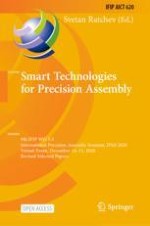1 The Concept of Assistance in Industry 4.0
1.1 Motivation and State of the Art
1.2 Structure, Usage and Purpose of Assistance Units
Characteristic feature | Example |
|---|---|
Description of the assistance unit | E.g. Assembly-Assistant |
Type of assistance | Cognitive, physical or hybrid |
Knowledge resources | E.g. data or media files required |
Input format | E.g. speech interface, user interface |
Input device(s) | E.g. microphone. |
Output format | E.g. video explaining the assembly process |
Output device(s) | E.g. tablet and in-built speaker |
Purpose | Capabilities (A/U = Assistance Unit) |
|---|---|
Mediator | A/U enables connection to/with a remote expert |
Tutor | A/U explains a certain procedure |
Trouble-shooter | A/U helps to localize a specific problem |
Guard | A/U observes a situation and reports observations |
Savior | A/U is called to clear up a known failure condition |
Helper | A/U takes over physical sub-tasks in collaboration |
Interpreter | A/U finds situation-relevant information from diverse sources, in an ill-defined problem space |
Avatar (for tele-presence) | A/U enables an expert to act in a remote location (requires e.g. tele-robotics and situation awareness) |
1.3 Assistance Units as Actors on the Shop-Floor
2 Situational Awareness and Assistance
3 Process Description as Frame for Situational Awareness
3.1 Pseudo-Natural Language for Process Steps, Observations and Interventions
transform [X] through [P] allows us to declare a subtask make-PU1-box which needs to be further specified elsewhere.Meta-language explanation | Language construct | Examples/Comments |
|---|---|---|
Assistance trigger | trigger (show-how | delay | behavior | panic) | Show-how is initiated by the worker; delay gets triggered when the time is used up; behavior is used when a deviation is observed; panic triggers a defined emergency procedure |
A/U Intervention control | On trigger T <action> … else | If trigger T is raised then do […], else do […] |
Object | product [ID] | We associate assembly tasks with products, e.g. PowerUnit-1 with some catalogue-ID |
Object | equipment [ID] | Instrumental objects such as tools, e.g. a screwdriver or a workbench, or an info-screen |
Object | material [ID] | A part made of homogeneous material, e.g. a metal base of some product |
Object | component [ID] | A specific functional part of a product that may itself be a subassembly or product |
Object | assembly [ID] | A non-functional intermediate state of a product during the manufacturing process |
Object | user [ID] | A human worker involved in the task |
Action | place (+ qualifiers) | E.g. place (from the left) … |
(More actions will need to be defined) | pick X from Y | E.g. taking a screw from a container |
(do) show X [to user] | What the A/U should display to the user | |
(do) ask [user] | What the A/U should ask the user | |
(do) help [user] | Refers to physical or reasoning help | |
A high- level action pointing to another task specification | Transform [X] through [P] into <object> newX | References a sub-process P, which transforms X into a new shape or form “NewX” e.g. creating a box out of some sheet of cardboard |
Spatial qualifiers | on top of | These are qualifiers that have a local interpretation from the worker’s point of view |
from the right from the left below, from below | They must be used carefully because they are relative to the worker’s assumed position | |
Domain-specific terms | [Dom-Spec-Term] | E.g. material [Bottom-cover] – the referenced objects must be recognizable for the assistance system through some identification mechanism (e.g. RFID, image recognition) |
